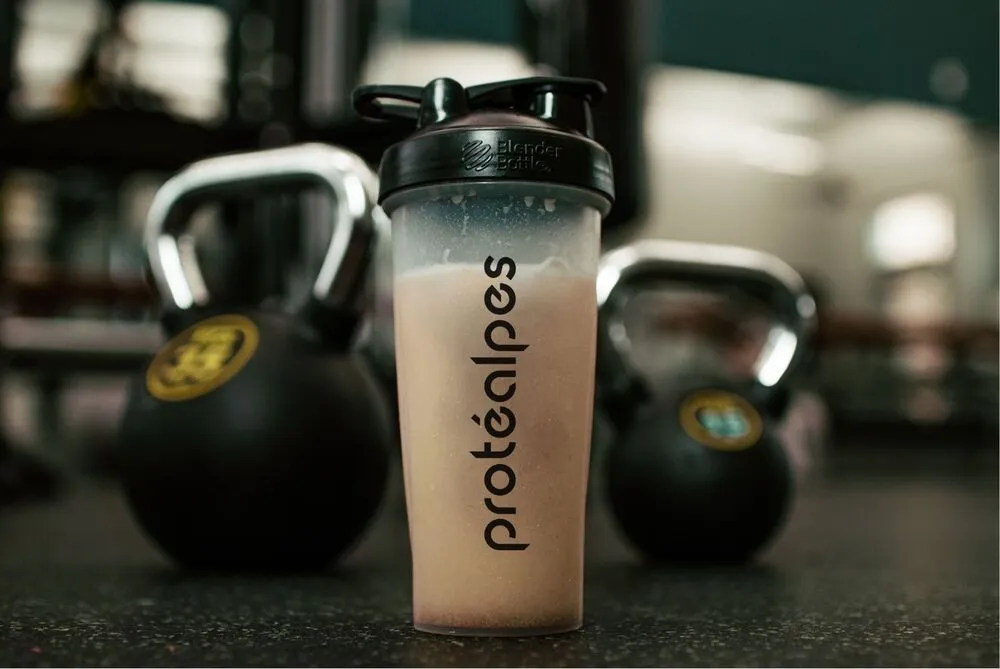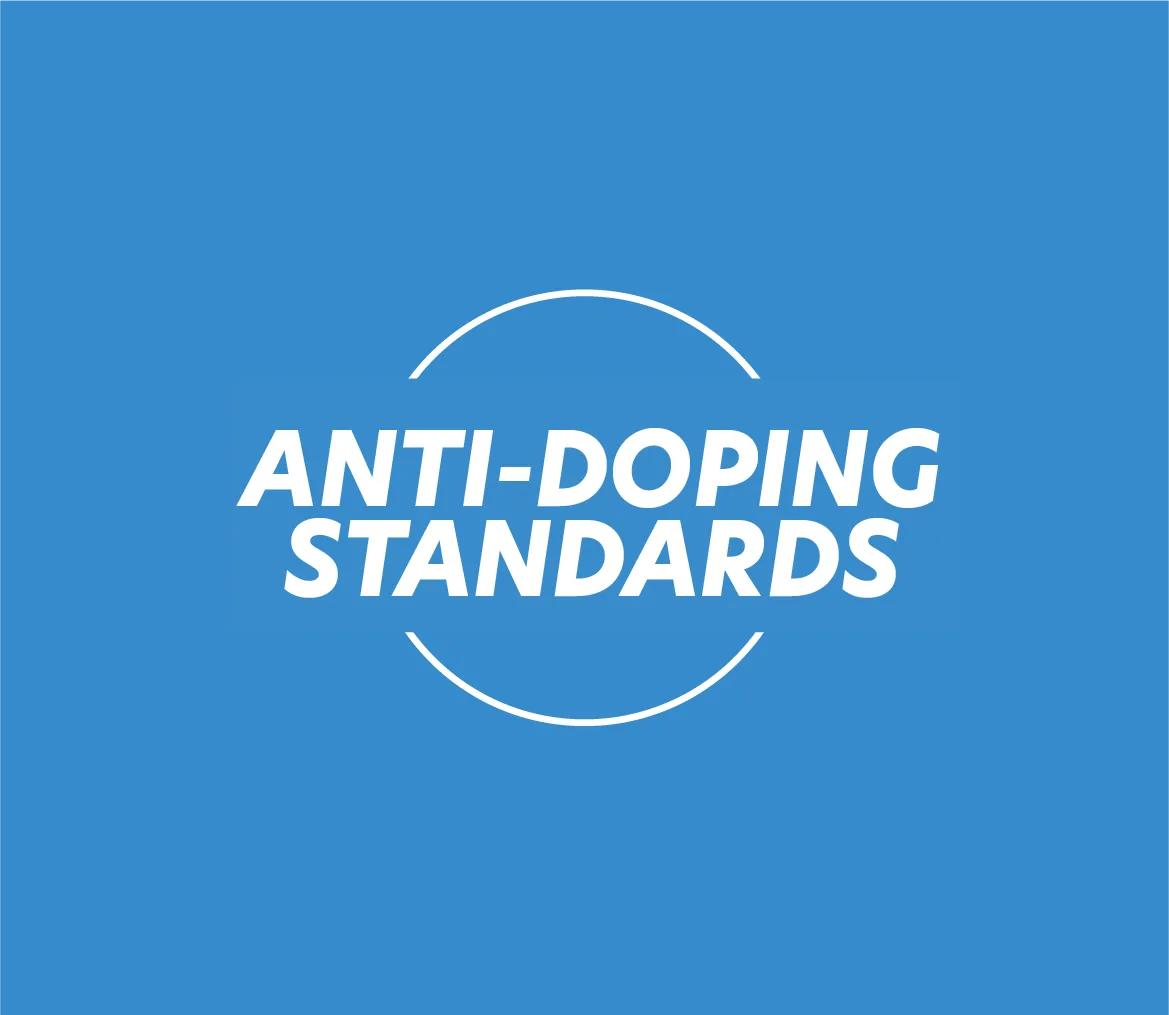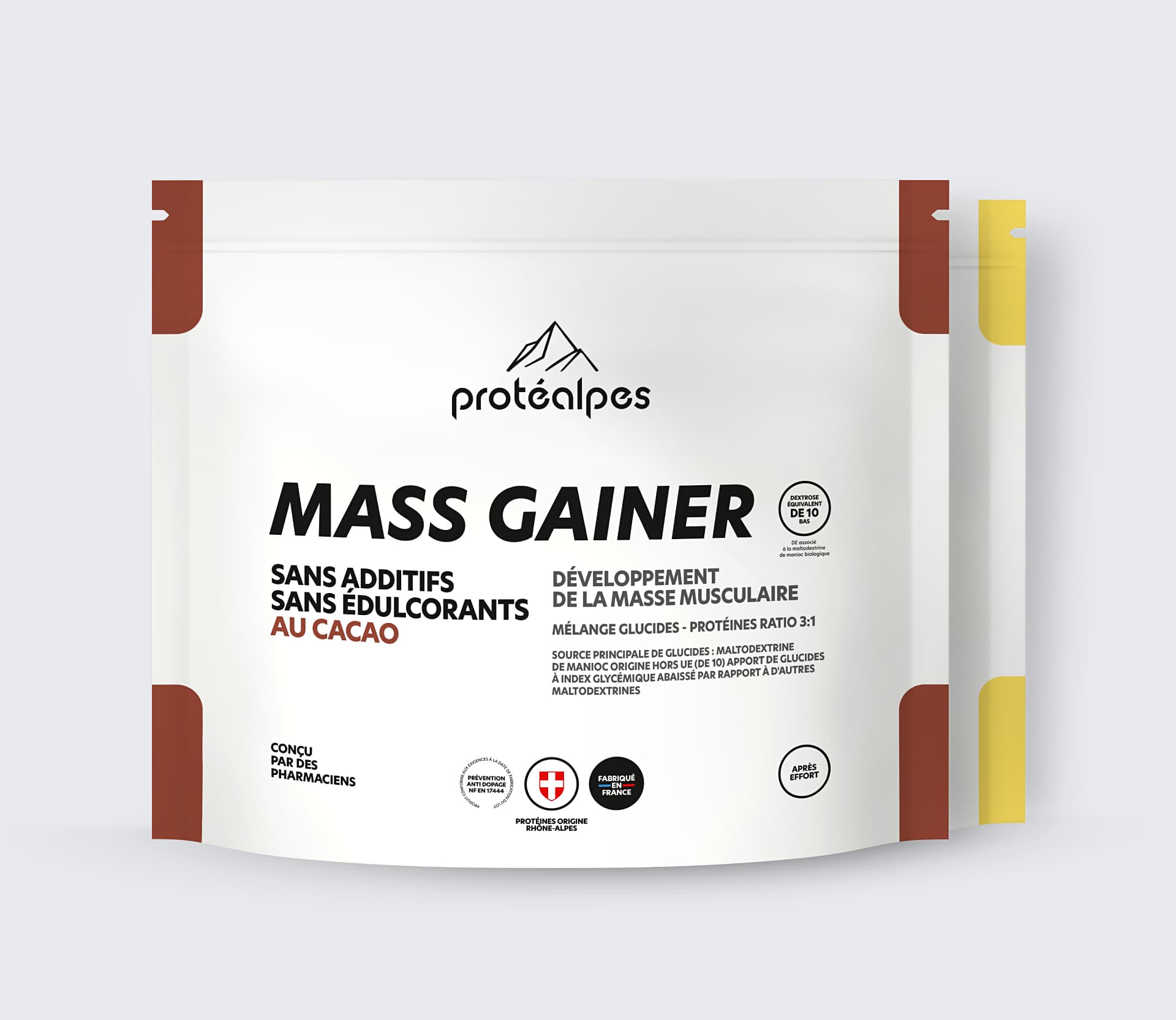
Protéalpes magazine
Weight gain: the complete guide for beginner athletes
Mass gain, a process aimed at increasing muscle mass, combines a nutrient-rich, balanced diet with specific training.
Essential for athletes wishing to gain in size and strength, it requires rigour and perseverance, involving calorie intake in excess of normal energy expenditure and targeted muscle strengthening.
Here's everything you need to know.
1. Fundamental principles of weight gain
Mass gain requires a structured approach combining targeted nutrition and appropriate training. The recommended intake is 45-55 kcal/kg and 1.8-2.2 g/kg/d of protein.
Requirements calculator
The macronutrient ratio should be 45-65% carbohydrates, 10-30% protein and 25-35% fat.
Please note that we're talking here about percentages of calorie intake, not percentages of the weights of the various macronutrients.
In terms of weight, the percentages are slightly higher for proteins and carbohydrates, which provide fewer calories than lipids (4 vs. 9 per 1 gram).
By weight, this gives 1.6 to 2.2 g/kg protein, 5 to 6 g/kg carbohydrates and 1 to 1.5 g/kg lipids.
A gradual approach is essential, increasing calorie intake by around 500 calories a week.
Intakes should be divided into 5-6 daily portions to facilitate nutrient absorption. Food quality takes precedence over quantity, with a focus on complete nutritional sources rather than "empty" calories. Hydration and recovery are as important as the training itself.
So nutrition for mass gain is the foundation of an effective program. But to put these basic principles into practice, it's essential to know how to calculate your individual calorie requirements.
Calculating calorie requirements for weight gain
Caloric requirements for mass gain are often calculated on the basis of Black's equation, taking into account age, sex, height and weight.
The basal metabolic rate represents the minimum calories required for the body to function. To these calories must be added those required for daily activity. Physical activity significantly increases these requirements, particularly in the case of intensive sports.
Let's start by calculating your basal metabolic rate:
A caloric surplus of 10 to 35% is then recommended for mass gain. Energy expenditure varies considerably according to the type of activity, level of intensity and duration. Regular monitoring of weight and body measurements enables calorie intake to be adjusted as progress is made.
How long does mass gain last?
Effective weight gain takes a minimum of 3 to 6 months to achieve significant results. The first visible changes appear after 4-6 weeks of structured training.
Beginners progress more rapidly in the first few months before reaching a plateau. The total duration of a massgain program can extend up to 18 months, depending on objectives and genetics.
Adopt a gradual progression to minimize fat gain. Regular follow-up allows you to adjust the program according to the results obtained. Patience and consistency are essential for lasting results.
Now that we've established the time and calculation framework for mass gain, we need to understand how to distribute these calories between the different macronutrients to maximize results.
Which exercises are best for building muscle mass?
For effective weight gain, training at the gym focuses on fundamental poly-articular exercises. The deadlift, squats, barbell rowing and bench press are 4 essential pillars that stimulate several muscle groups simultaneously.
To maximize muscle hypertrophy, sets can be structured on this basis:
- 3-4 exercises per muscle group
- 3-5 sets per exercise
- 8-12 repetitions per set
- 70-85% of maximum load

Large muscle groups (back, thighs, pectorals) require 120-150 total reps per session, while smaller ones (biceps, triceps) require 60-80 reps.
To optimize muscle volume, it's important to alternate between myofibrillar hypertrophy (heavy loads, 6-8 repetitions) and sarcoplasmic hypertrophy (moderate loads, 8-12 repetitions). Rest time should be adapted to the effort of the series, generally between 1 and 2 minutes.
How long does mass gain last?
What is basal metabolic rate?
What is the macro-nutrient ratio to aim for?
2. How do you structure your diet for weight gain?
How much protein do you need to build muscle?
Protein requirements for mass gain are between 1.6 and 2.2 grams per kilogram of body weight per day.
This quantity is essential for muscle building and recovery. It is important to choose complete proteins containing all the essential amino acids. Protein consumption should be spread out over the day to maintain a constant flow of amino acids.
The best sources include lean meats, eggs, fish and dairy products. Excess protein above 2.2g/kg/day brings no additional benefits, so you may as well avoid the risk of overloading the body.
To optimize protein assimilation and support physical effort, carbohydrates play a decisive role.
Vary the weight with the
How many carbohydrates do you need to build muscle mass?
It's often forgotten, but you need carbohydrates to build muscle. Carbohydrates are the main fuel for muscles during exercise, and are crucial for replenishing muscle glycogen.
Insulin production stimulated by carbohydrates promotes protein absorption. Wholegrain cereals, rice and potatoes are ideal sources.
In addition to proteins and carbohydrates, lipids play an essential role in hormonal balance.
How much fat should I take for weight gain?
Lipids account for 25-35% of total calorie intake when building mass. They are essential for hormone production, particularly testosterone. Good fats such as omega-3 reduce inflammation and improve recovery.
A minimum fat intake during the period of mass gain is crucial to maintain a hormonal environment favourable to muscle growth. Recommended sources include olive oil, rapeseed oil, avocados, oily fish and oilseeds.
To integrate these macronutrients effectively, it's important to choose the best foods. Supplementation should only be used in support of an intelligent, pragmatic dietary program.
Foods to choose
Successful weight gain requires foods of high nutritional quality. Lean meat, fish and eggs from responsible livestock farms are ideal sources of protein.
Whole grains provide essential complex carbohydrates. Fermented foods improve intestinal health and nutrient absorption. Quality of food sources is more important than quantity.
Selecting the best foods for mass gain is only the first step, then the optimal distribution of these foods throughout the day is just as important as their selection.
How many meals a day should I eat to gain weight?
The ideal number of meals per day for weight gain will depend on a number of factors. The ideal frequency is between 4 and 6 meals a day to maintain a regular intake of nutrients.
Snacks between meals make it easier to reach calorie targets. It is advisable to adapt meal timing to training schedules. Protein intake every 3-4 hours optimizes protein synthesis. Sleep quality and digestion should also be taken into account when planning meals.
Now that we've established the basics of an optimal diet, it's worth exploring how dietary supplements can support this nutritional strategy.
Essential for protein synthesis
Prevents hunger peaks
High protein intake
Energy for the session
Night-time recovery and synthesis
Ideal interval:
3-4 hours between meals
3. The role and real impact of supplements in mass gain
What are the best dietary supplements?
When it comes to building muscle mass, certain dietary supplements stand out from the crowd.
- At the top of the list are protein powders, essential for meeting daily protein targets.
- Although creatine monohydrate has no direct effect on muscle growth, it does optimize training performance.
- Gainers are a practical solution for people struggling to reach their calorie targets, such as certain ectomorphs.
As their name suggests, these supplements are not intended to replace dietary intake. They should be seen as an extension of a healthy, balanced diet.

Choosing the ideal whey for weight gain
Whey is the most effective protein supplement for mass gain, thanks to its natural richness in essential amino acids and BCAAs. Its high bioavailability makes it an ideal choice for post-workout recovery.
High-quality whey is free from additives and sweeteners, and ideally derived from pasture-fed, extensively farmed milk. Gainers, combining whey and carbohydrates, are particularly suitable for ectomorphs, people with high caloric needs or those seeking faster mass gain. The recommended dose varies according to dietary protein intake, but it is not recommended to exceed 2.2 g/kg/day.
To optimize performance and complement the action of whey, creatine offers specific benefits.
Whey/water dosage calculator
Use the slider to select the quantity of whey in grams. The calculator works for all our protein powders (whey, mass gainer, pro-recovery...).
Creatine for weight gain
Although creatine does not directly influence muscle growth, it significantly improves performance during intense efforts. By enabling better ATP regeneration, it increases the ability to lift heavier loads and perform more repetitions.
The recommended dose of creatine for mass gain is 3-5 g per day, ideally after training, with carbohydrates. Creatine quality is crucial. We recommend the certified monohydrate form Creapure®.
An initial loading phase (not compulsory) of 20 g/d in 2 to 4 doses over 5 days can accelerate saturation of muscle reserves, before moving on to a maintenance dose of 3-5 g/d.
Is it necessary to take omega-3 for weight gain?
Omega-3s, particularly EPA and DHA, play an essential role in reducing the inflammation associated with intensive training. These essential fatty acids also improve insulin sensitivity, promoting nutrient absorption.
Focus on dietary sources such as oily fish, rapeseed oil and nuts before considering supplementation.The effect of omega-3s in the diet is particularly interesting when combined with an adequate protein intake and regular training.
Now that we've explored the main dietary supplements, it's crucial to understand how to optimize their use through precise timing and proper hydration.
4. The best timing for snacks and workouts
Post-training nutrition
The post-training period represents a crucial window of opportunity for muscle recovery and growth. Muscles are particularly receptive to nutrients during this phase, and require a combined intake of proteins and carbohydrates.

Muscle protein synthesis is optimal within two hours of exercise, although this window is more flexible than originally thought. Combining 20-25g of protein with carbohydrates promotes muscle glycogen replenishment and tissue repair. Essential amino acids, particularly leucine, play a key role in this process.
To maximize these benefits, the precise timing of dietary supplements deserves particular attention. But generally speaking, it's crucial to remember that the most important thing is the total protein and calorie intake over the day, rather than the precise moment of intake.
When should you use your gainer?
The best times to consume a gainer vary according to your objectives and training schedule. Post-workout intake promotes recovery and muscle growth, while consumption in the morning for breakfast stops nocturnal catabolism.
It can also be incorporated into high-protein recipes for snacks.
Intake before bedtime will be beneficial if the gainer is combined with foods that slow down digestion. When building mass, it is crucial to avoid taking protein just before a meal, so as not to compromise appetite.
When dividing your intake over the day, take into account your main meals and your training schedule. Remember that the most important thing is to have an energy intake > to the expenditure, based on a healthy diet over the long term.
This nutritional planning would not be complete without an appropriate hydration strategy. 💦
Hydration for weight gain
Hydration plays a fundamental role in performance and muscle recovery. Dehydration of just 2% of body weight reduces performance by up to 30%.
Regular water consumption throughout the day, with particular attention to training sessions, is essential. Electrolytes, particularly sodium, help maintain water balance and muscle function. An athlete should consume between 2.7 and 3.7 liters of water a day, depending on activity levels and environmental conditions.
Having mastered these general aspects of sports nutrition, it's important to adapt these principles to the specific needs of each individual, particularly according to gender and morphotype.

5. Special cases and recipes
Weight gain for women
Weight gain in women requires a specific approach due to hormonal differences, notably the menstrual cycle and lower testosterone levels than men. Nevertheless, the broad outlines of the recommendations remain the same as for men.
Diet plays a crucial role, with a requirement of around 40 kcal/kg/day and 1.6-2g/kg/day of protein. Training should be designed with sufficient rest to allow for recovery.
That said, the menstrual cycle directly influences a woman's ability to gain muscle mass, with an optimal period during the follicular phase when insulin sensitivity is heightened and protein synthesis is more efficient.
The luteal phase, on the other hand, is marked by increased catabolism and more difficult recovery, requiring particular attention to protein and carbohydrate intake. To optimize muscle gains, women should schedule their most intense strength training sessions during the follicular phase, while the luteal phase should be devoted to less intense workouts with a more moderate volume. This cyclical approach to training maximizes results while respecting the natural hormonal variations of the female body.
Weight gain for ectomorphs
Ectomorphs, characterized by a rapid metabolism and difficulty gaining weight, require a specific nutritional approach with 50-55 kcal/kg/day (gradually attained) and an intake of 2 g to 2.2 g/kg/d total protein. The training program for ectomorphs gaining mass is intensive, but spaced out to optimize recovery.
The weight-training program for a beginner ectomorph is limited to a maximum of 3 sessions per week, due to their high susceptibility to overtraining, and requires at least one full day's rest between each session. Sessions should be intense, focusing on basic poly-articular exercises such as the squat, bench press and deadlift. Loads and sets should be varied, alternating heavy loads/short sets and lighter loads/long sets.
Ectomorphs need to adapt their range of movement, as their long limbs create considerable leverage. In the early stages, it's a good idea to limit (but not eliminate) calorie-burning cardio sessions for muscle stimulation not related to weight gain.
 Ectomorph
Ectomorph  Mesomorphic
Mesomorphic  Endomorph
Endomorph 
Gainers for ectomorphs
To compensate for their rapid metabolism and successfully gain mass, ectomorphs benefit from gainers, dietary supplements combining proteins and carbohydrates.
Coach's tip: opt for an additive-free gainer with 20-25g of protein and at least 60g of carbohydrates per portion. Take after meals to avoid suppressing your appetite.
Food programs
| Program | Profile | Calories (kcal) | Protein (g) | Carbohydrates (g) | Fat (g) | Macronutrient ratio |
|---|---|---|---|---|---|---|
| Basic Balanced (65 kg) | Beginners in bodybuilding | 2994 | 135 | 366 | 110 | 18% P, 49% G, 33% L |
| Flexitarian (75 kg) | People who limit meat | 3551 | 155 | 402 | 147 | 17% P, 45% G, 37% L |
| High-calorie (75 kg) | Ectomorphs and hardgainers | 4056 | 154 | 500 | 160 | 15% P, 49% G, 36% L |
| Women's special (55 kg) | Adapted to female physiology | 2130 | 105 | 270 | 70 | 20% P, 51% G, 30% L |
- Importance of hydration (minimum 2L/day)
- 48-hour rest between sessions for the same muscle groups
- Food quality over quantity
- 3 main meals + snacks
Recipes for homemade gainers
For those who prefer to control their ingredients, Protéalpes offers 15 recipes for homemadegainers, ranging from the classic chocolate-almond butter to the more original avocado-spinach. These recipes make it possible to achieve high calorie intakes while avoiding the additives of certain commercial products. Each recipe is accompanied by precise nutritional values and preparation instructions.
Whether you follow our recipes or let your imagination run wild, remember that results come from consistency and quality ingredients.
Scientific sources
Omega-3 & muscle mass
- (2020) Potential of Omega-3 Supplementation on Muscle Mass, Muscle Strength, and Physical Performance in Elderly Community
- (2022) Plasma omega-3 is not associated with appendicular muscle mass index in young and middle-aged individuals: Results from NHANES 2011-2012
- (2023) Effects of Omega-3 Supplementation Alone and Combined with Resistance Exercise on Skeletal Muscle in Older Adults: A Systematic Review and Meta-Analysis
- (2022) Plasma omega-3 fatty acids are positively associated with appendicular muscle mass index only in adults with low protein intake: Results from NHANES 2011-2012
Hydration & performance
- (2015) Dehydration and Its Effects on Performance
- (2018) Development of Urine Hydration System Based on Urine Color and Support Vector Machine
Protein & nutrition
- (2014) Effects of protein supplements on muscle mass, strength, and aerobic and anaerobic power in healthy adults
- (2000) Protein feeding pattern does not affect protein retention in young women
- (2015) Protein Ingestion before Sleep Increases Muscle Mass and Strength Gains during Prolonged Resistance-Type Exercise Training in Healthy Young Men
- (2016) Pre-sleep protein ingestion to improve the skeletal muscle adaptive response to exercise training
Creatine & muscle strength
- (2003) Effects of creatine supplementation and resistance training on muscle strength and weightlifting performance
- (1996) Muscle creatine loading in men
Other recent studies
- (2023) The effect of pre-exercise protein intake on substrate metabolism, energy expenditure, and energy intake: a dose-response study
- (2013) Nutrient timing revisited: is there a post-exercise anabolic window?
Health Performance
Transparency
Protéalpes supports athletes in their training programs to improve recovery and performance.








